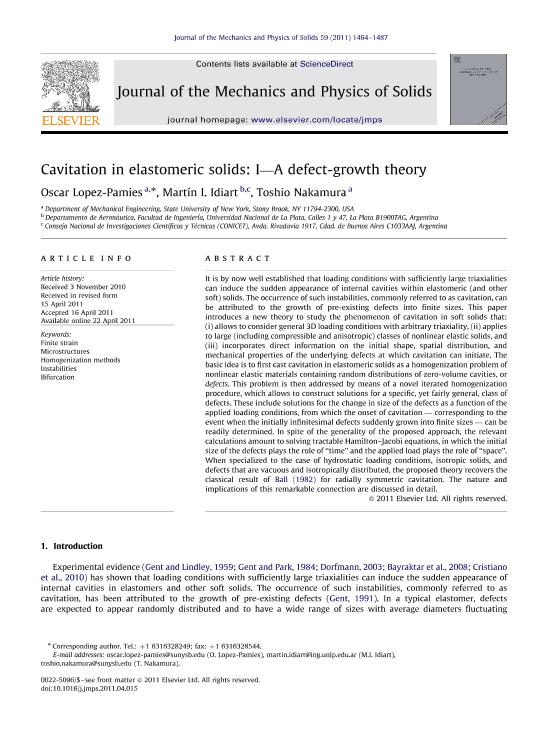Artículo
Cavitation in elastomeric solids: I—A defect-growth theory
Fecha de publicación:
08/2011
Editorial:
Pergamon-Elsevier Science Ltd
Revista:
Journal of the Mechanics and Physics of Solids
ISSN:
0022-5096
Idioma:
Inglés
Tipo de recurso:
Artículo publicado
Clasificación temática:
Resumen
It is by now well established that loading conditions with sufficiently large triaxialities can induce the sudden appearance of internal cavities within elastomeric (and other soft) solids. The occurrence of such instabilities, commonly referred to as cavitation, can be attributed to the growth of pre-existing defects into finite sizes. This paper introduces a new theory to study the phenomenon of cavitation in soft solids that: (i) allows to consider general 3D loading conditions with arbitrary triaxiality, (ii) applies to large (including compressible and anisotropic) classes of nonlinear elastic solids, and (iii) incorporates direct information on the initial shape, spatial distribution, and mechanical properties of the underlying defects at which cavitation can initiate. The basic idea is to first cast cavitation in elastomeric solids as a homogenization problem of nonlinear elastic materials containing random distributions of zero-volume cavities, or defects. This problem is then addressed by means of a novel iterated homogenization procedure, which allows to construct solutions for a specific, yet fairly general, class of defects. These include solutions for the change in size of the defects as a function of the applied loading conditions, from which the onset of cavitation — corresponding to the event when the initially infinitesimal defects suddenly grown into finite sizes — can be readily determined. In spite of the generality of the proposed approach, the relevant calculations amount to solving tractable Hamilton–Jacobi equations, in which the initial size of the defects plays the role of “time” and the applied load plays the role of “space”. When specialized to the case of hydrostatic loading conditions, isotropic solids, and defects that are vacuous and isotropically distributed, the proposed theory recovers the classical result of Ball (1982) for radially symmetric cavitation. The nature and implications of this remarkable connection are discussed in detail.
Archivos asociados
Licencia
Identificadores
Colecciones
Articulos(CCT - LA PLATA)
Articulos de CTRO.CIENTIFICO TECNOL.CONICET - LA PLATA
Articulos de CTRO.CIENTIFICO TECNOL.CONICET - LA PLATA
Citación
Lopez Pamies, Oscar; Idiart, Martín Ignacio; Nakamura, Toshio; Cavitation in elastomeric solids: I—A defect-growth theory; Pergamon-Elsevier Science Ltd; Journal of the Mechanics and Physics of Solids; 59; 8; 8-2011; 1464-1487
Compartir
Altmétricas




